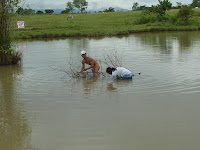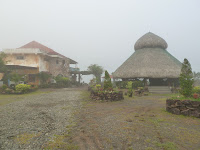Let's Go See Some Ordinary Places
The places Jegs and I have visited the
last month are certainly not out of this world.
They’re as ordinary as anything one can see. Perhaps the only difference is that I looked
at them from another point of view.
Let me begin with a few more details
found in Panyesanan, the Garden-in-the-Farm place of my brother, retired UPLB-CHE
Dean Flor Librero in Bgy. Rizal, Lipa City.
Among others, this dwarf pomelo is quite productive.
It didn’t come from a real dwarf variety, but
it has been bearing fruits in spite of its size. The fruit is sweet considering it comes from
Bangkok, courtesy of Dean Flor’s old friend, Dr. Pot of Kasetsart University,
who brought with him an entire pomelo fruit when he visited Panyesanan many
years ago. Dean Flor and Dr. Pot were
classmates in their PhD years at Louisiana State University in the USA. Dr. Pot passed away about fifteen years ago.
At Panyesanan, one can also enjoy a
small population (just about 40 heads) of noisy geese (specially when strangers
keep on coming closer), and sheep (about 140 heads) grazing in
the open grassland or under the shades.
If you go anywhere in the pasture area, holding leaves of banana, you
can be sure they’ll come surrounding you until you give them their share of the
banana leaves. Those that do not get
their share would simply leave with the others probably thinking, “oh, well, maybe it’s
not our day yet.” Unlike, people, they’ll
not make a fuss.
Also,
during the last couple of weeks, Jegs and I visited one resto in Sta. Rosa City
and saw this … Symbol of the resto's clients, perhaps?
Back at UPLB, whenever Jegs and I go
jogging, Waku, our Shi Tzu pet, always comes along. In one of those jogging sessions, he looked
very interested, although a bit tired.
On November 8th, Jegs
accompanied me to Cabagan, Isabela, where I gave the Keynote Address before the
2nd national conference of the Consortium of Development
Communication Educators and Practitioners in the Philippines (CDEPP).
Along the way, we saw quite a few
sceneries that caught our attention. For
example, here’s a couple harvesting snails from a pool of water on the rice land
near PhilRice in Muños, Nueva Ecija. Interesting that there is still water in this paddy after sometime of dry season.
Farther up north, I didn’t take
pictures of the road construction going on at Dalton Pass, but the work simply
stalled traffic for hours.
When we got
to the Sta. Fe (Nueva Viscaya) side and on to the interior of Nueva Viscaya, we
saw the hills completely denuded. Of
course, this has been there for many, many years now, but with this scenery do you still really wonder why the river bed is dry?
Or why there are frequent floods?
When we got to Cordon, Isabela, we
stopped by this new facility that boasts it has the best restrooms. Indeed, the restrooms were beautiful and
clean. They’re probably very new, too. Travelers do take their meals here, but the
things you can buy from this facility are available in most convenient stores
in the Metropolis. They should be selling
more native products from Isabela and Nueva Viscaya in this place. But, of course, that's my opinion only.
When we got to ISU Cabagan Campus,
some 14 hours drive from Los Baños, we were billeted at the Ranch-Residential
house of Isbela Vice Governor Rodito Albano (we were, after all, in Albano country) on a hill in a 1,000 hectare ranch
at the outskirts of Cabagan. We were billeted (two nights)
in this Ranch House with a Mexican-oriented architecture courtesy of the Vice Governor’s old friend and a
former student of mine, Prof. Toni Bacullug of ISU Cabagan. We had the Ranch House all to ourselves because
the Vice Governor, we were informed, was on vacation in Europe. We moved around the area, enjoying the exterior scenery, but kept out of other interior areas except in the guest room assigned to us. We were treated very well by the courteous staff. We learned the Vice Governor is well-loved in Isabela. In fact, we learned he's running for Congressman unopposed.
I don’t know how many heads of cattle there were in the ranch, but we saw a small herd roaming around near the house. From this hilltop ranch rest house, we could see the province of Cagayan and part of the Cagayan River winding through the plains. Jegs and I enjoyed the outdoor patio of the rest house.
In the morning we woke to appreciate
the thick fog, which does happen only now and then, according to the caretaker.
The opening of the conference had the
following guests: (L-R) Dr. Edwin Macabullog, ISU-Cabagan Campus Executive
Director; Hon. Christopher Mamauag, Mayor of Cabagan; Dr. Serlie Jamias,
President of CDCEPP, and Dr. Lex Librero, Keynote Speaker, all listening to the
Executive Assistant of the Governor of Isabela delivering the welcome message
of Gov. Faustino Dy III, who was unable to attend.
After the opening program and the
keynote address, the participants of the conference were very busy with the
photo-ops.
Smaller groups had their pictures
taken with us after the main photo-ops.
My message to the participants of the
conference was: Devcom as Mindset, is it Possible? After my speech, there was a lengthy open
forum where participants asked me to respond to specific issues about
contemporary issues on development communication, to which I gamely responded. I think that the participants understood me
when I said that when we communicate we do not intend to be a pure development
communicator, or mass communicator, or corporate communicator, but our act of
communicating is so labeled according to the context in which we communicate so
that some may call us as development communicators, or mass communicators, or
corporate communicators, or some other classification. What makes your communication different is
the context in which you are communicating.















No comments:
Post a Comment